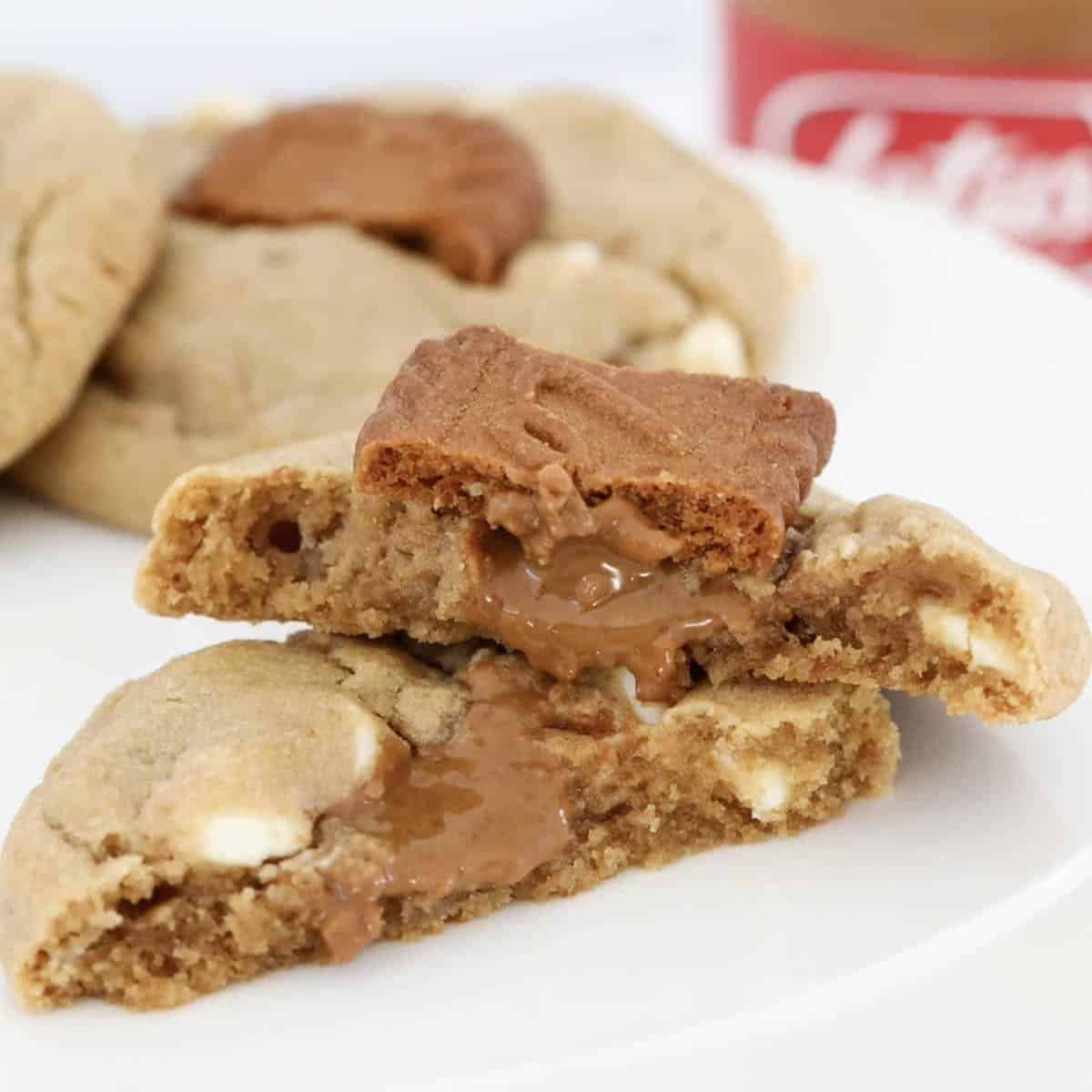
Biscoff Cookies
Biscoff Cookies filled with gooey Biscoff spread and lots of white chocolate chips!
Print
Pin
Servings: 15 serves
Calories: 317kcal
Cost: $5
Equipment
- Beaters, stand-mixer or Thermomix
- Oven
Ingredients
- 80 g (⅓ cup) Biscoff spread for freezing in dollops
- 120 g (½ cup) extra Biscoff spread
- 125 g (½ cup) butter room temperature
- 160 g (1 cup) brown sugar
- 1 egg room temperature
- 2 teaspoon vanilla extract
- 260 g (1 ½ cups) plain flour
- 1 teaspoon bi-carbonate soda
- pinch of salt
- 190 g (1 cup) white chocolate chips
- 100 g Biscoff cookies roughly chopped
Instructions
Conventional Method
- Place 15 x ½ teaspoon dollops of Biscoff spread (⅓ cup) onto a baking paper lined tray. Freeze for 15 minutes or until solid.
- Cream the Biscoff spread (½ cup), butter and brown sugar with hand-held beaters or a stand mixer on medium/high speed for 3-4 minutes or until pale and creamy. If using a Thermomix: Insert the butterfly into the Thermomix bowl. Add the Biscoff spread (½ cup), butter and brown sugar and mix for 3 minutes, Speed 3 (scraping down the sides occasionally).
- Add the egg and vanilla extract and beat again on medium speed until combined.If using a Thermomix: Add the egg and vanilla extract and mix for 1 minute, Speed 3.
- Add the plain flour, bi-carb soda and salt and beat on low speed until combined.If using a Thermomix: Remove the butterfly. Add the plain flour, bi-carb soda and salt and mix for 30 seconds, Speed 3. Scrape down the sides of the bowl and mix again for an extra 30 seconds.
- Sprinkle the white chocolate chips over the mixture and stir through with a spoon or spatula. Chill the dough in the fridge for 20 minutes.
- Preheat oven to 170 degrees celsius (fan-forced). Line 2 large flat baking trays with baking paper and set aside.
- Divide the mixture into 15 portions. Flatten each portion and place a frozen dollop of Biscoff in the centre. Roll to enclose. Place onto the prepared trays, leaving a 8cm gap between each dough ball to allow for spreading.
- Press a piece of chopped Biscoff biscuit into the top of each dough ball.
- Bake for 10-12 minutes or until just ever so slightly golden around the edges (don't overcook). Rotate the trays during cooking.
- Leave on the trays for 5 minutes and then transfer to a wire rack to cool completely.
Notes
RECIPE NOTES & TIPS
- Freezing small portions of the spread first makes it easier to handle when enclosing inside the cookie dough, and from melting through when baking.
- Cream the brown sugar and butter until well combined, but don't overbeat. Excess beating can soften the butter too much, particularly in warmer weather.
- Chilling the dough makes it easier to handle when rolling, and helps to prevent the cookies from spreading too much once baking.
- You want uniform size so that they bake evenly, so try measuring out your dough balls.
- Ensure you leave a large gap (about 8 cm) between the cookies on the baking tray as they will spread.
- Keep a good eye of these cookies as they bake, you don't want to overbake them as you want them to remain soft. Rotate the trays when baking.
- Storing - Biscoff cookies can be stored in an airtight container at room temperature for up to a week.
- Freezing - the unbaked dough can be rolled into a ball and covered in plastic wrap. Freeze for up to 3 months. The baked cookies can be frozen in an airtight container (with layers of baking/parchment paper between each layer) for up to 1 month.
Nutrition
Calories: 317kcal | Carbohydrates: 38g | Protein: 4g | Fat: 17g | Saturated Fat: 8g | Polyunsaturated Fat: 1g | Monounsaturated Fat: 3g | Trans Fat: 0.3g | Cholesterol: 31mg | Sodium: 145mg | Potassium: 76mg | Fiber: 0.5g | Sugar: 22g | Vitamin A: 228IU | Vitamin C: 0.1mg | Calcium: 40mg | Iron: 1mg